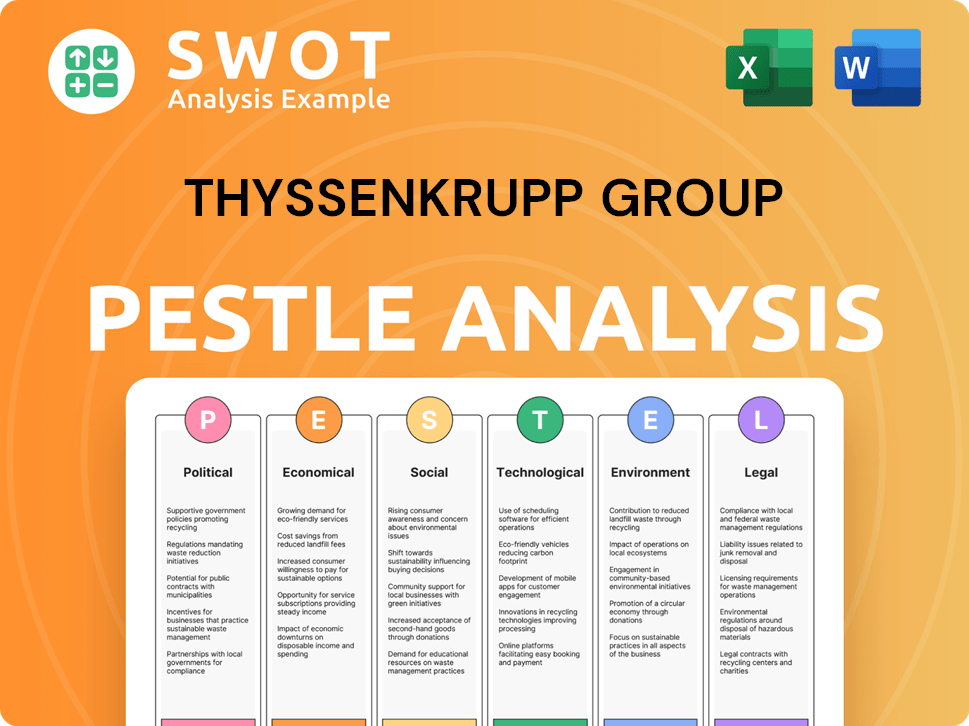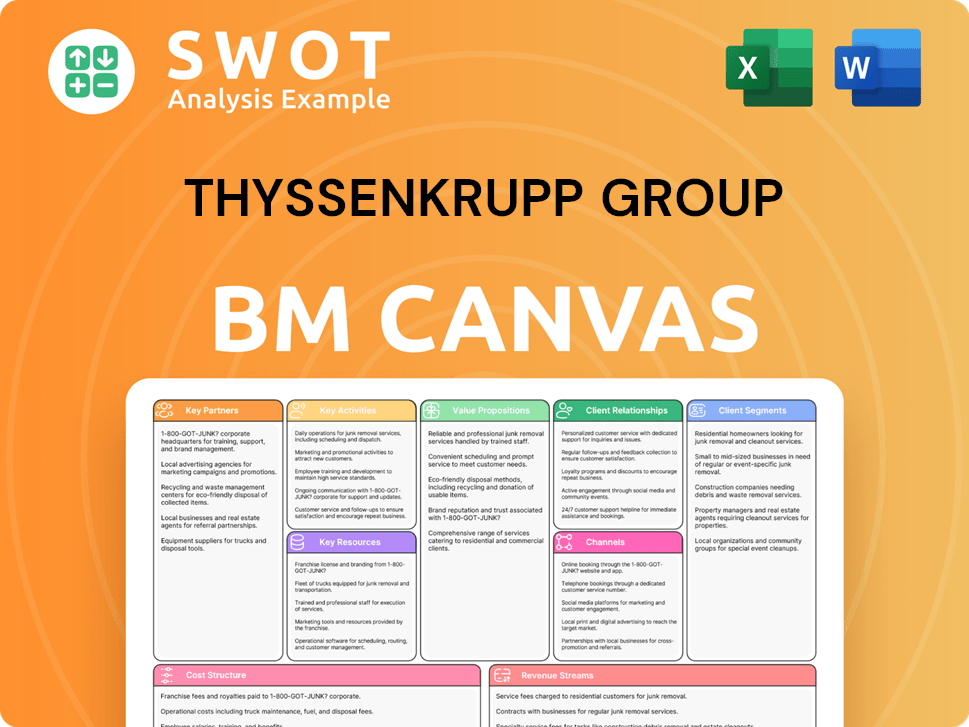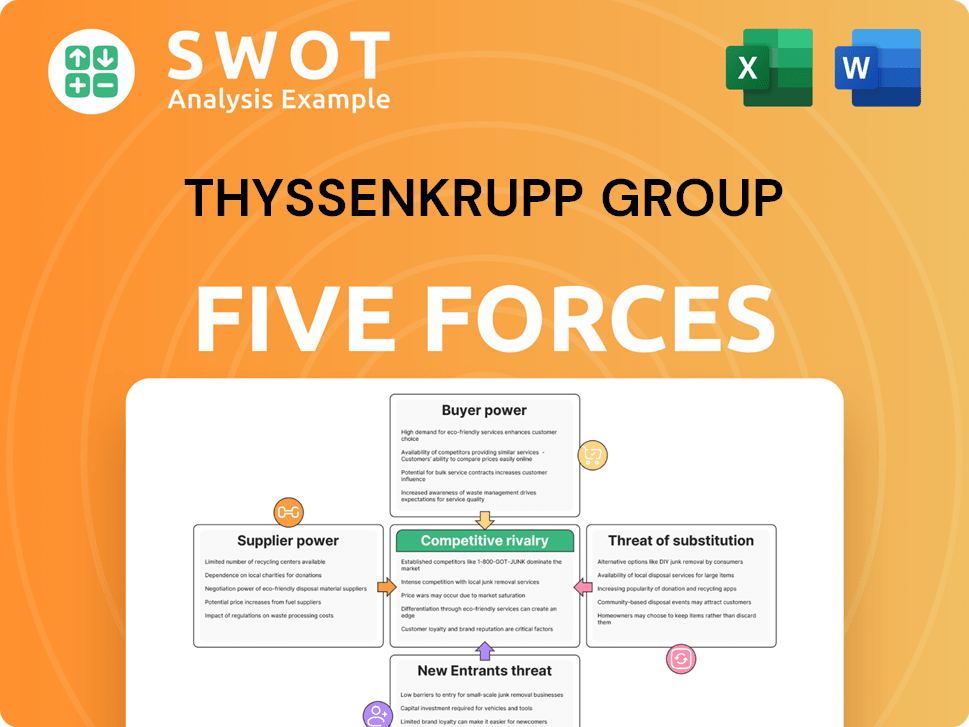ThyssenKrupp Group Bundle
How Did a German Steel Giant Become a Global Industrial Powerhouse?
Delve into the captivating ThyssenKrupp Group SWOT Analysis, a company whose legacy is etched in the annals of industrial innovation. From its roots in 19th-century Germany, ThyssenKrupp's story is one of bold engineering feats and strategic evolution. This German industrial giant has consistently adapted to the changing tides of global markets, leaving an indelible mark on sectors worldwide.

The ThyssenKrupp history is a testament to the power of vision and resilience. Initially focused on steel manufacturing, the company's early years were defined by groundbreaking advancements. Today, ThyssenKrupp Group's influence spans across automotive components, and more, showcasing its remarkable journey of growth and diversification. Explore the brief history of ThyssenKrupp to understand its current status and challenges.
What is the ThyssenKrupp Group Founding Story?
The story of the ThyssenKrupp Group is a tale of two powerful German industrial legacies merging to create a global powerhouse. The company's roots are deeply embedded in the histories of Krupp and Thyssen, both significant players in Germany's industrial revolution. This Revenue Streams & Business Model of ThyssenKrupp Group is a testament to the company's evolution.
Friedrich Carl Krupp laid the foundation for his company on November 20, 1811, in Essen, Germany, with a focus on producing high-quality cast steel. Alfred Krupp, Friedrich's son, played a crucial role in perfecting steel production through extensive testing. Meanwhile, August Thyssen established Thyssen & Co. in 1871, initially as an iron strip rolling mill, later expanding into steel production.
These two companies, each with its own unique origins and strategic moves, eventually came together to form the ThyssenKrupp Group, a German industrial giant with a significant impact on the global market.
The ThyssenKrupp history begins with two separate entities, each with its own founding story and key milestones.
- Friedrich Carl Krupp founded a cast steel factory in Essen, Germany, on November 20, 1811, focusing on high-quality steel.
- August Thyssen established Thyssen & Co. on April 1, 1871, near Mülheim an der Ruhr, initially as an iron strip rolling mill.
- Alfred Krupp's relentless pursuit of perfecting crucible steel production through extensive testing.
- August Thyssen acquired Gewerkschaft Deutscher Kaiser in 1891, integrating coal mining with steel production.
ThyssenKrupp Group SWOT Analysis
- Complete SWOT Breakdown
- Fully Customizable
- Editable in Excel & Word
- Professional Formatting
- Investor-Ready Format

What Drove the Early Growth of ThyssenKrupp Group?
The early growth of the entities that would become the ThyssenKrupp Group was marked by significant expansion and diversification. Both Krupp and Thyssen & Co. experienced substantial growth in the 19th and 20th centuries, driven by technological advancements and strategic acquisitions. These early developments laid the groundwork for the eventual merger and the formation of a major German industrial giant.
Under Alfred Krupp's leadership, the company's growth began in 1847, fueled by the demand for durable cast steel from the expanding railroad industry. Krupp supplied axles, springs, and tires, and by 1852, it invented the seamless forged and rolled railroad tire, a global bestseller. In 1859, Krupp entered arms manufacturing, producing complete artillery and constructing the first Bessemer steel plant on the continent in 1862. To secure its raw material supply, Krupp acquired iron ore mines and established a shipping company.
Thyssen & Co. initially focused on producing hoop iron and expanded into steelmaking, tube mills, and machine shops. August Thyssen modernized iron and steel production, expanding both raw material bases and processing capacities. This included acquiring shares in ore mines and transportation companies abroad, marking the Thyssen Group's first internationalization. The company's focus on steel manufacturing and automotive components solidified its position in the industry.
The 1950s saw further modernization, with Thyssen-Hütte commissioning the first continuous hot strip mill in Germany after World War II in 1955. A predecessor company of ThyssenKrupp Nirosta GmbH operated the first Sendzimir rolling mill for cold rolling stainless steel in 1957, revolutionizing stainless steel production. These advancements were critical in the company's history.
Close cooperation between the two companies began in the 1980s, combining their flat steel activities in 1997. This collaboration led to the full merger into ThyssenKrupp AG on March 17, 1999. The merger created a powerful entity in the global market. The merger was a strategic move, combining the strengths of both companies to create a more competitive and diversified business.
ThyssenKrupp Group PESTLE Analysis
- Covers All 6 PESTLE Categories
- No Research Needed – Save Hours of Work
- Built by Experts, Trusted by Consultants
- Instant Download, Ready to Use
- 100% Editable, Fully Customizable

What are the key Milestones in ThyssenKrupp Group history?
The ThyssenKrupp history is marked by significant achievements and strategic shifts. From its roots in the 19th century to its evolution as a German industrial giant, the company has navigated numerous challenges and innovations, shaping its position in the global market. Understanding the ThyssenKrupp Group's journey provides insights into the broader trends in steel manufacturing and the automotive components sector.
| Year | Milestone |
|---|---|
| 1852 | Krupp invented the seamless railroad tire, revolutionizing rail transport. |
| 1862 | Krupp pioneered the first Bessemer steel plant on the continent, enabling mass production. |
| 1999 | Thyssen and Krupp merged, forming ThyssenKrupp AG. |
| May 2024 | ThyssenKrupp Materials Services launched a new steel service center in Sinton, Texas, with a $32 million investment. |
ThyssenKrupp company has consistently pushed the boundaries of technological advancement. The company has been a pioneer in various fields, from steel production to materials services, with a strong focus on research and development.
Krupp's invention of the seamless railroad tire in 1852 was a breakthrough, enhancing the safety and efficiency of rail transport. This innovation provided unbreakable components for railway systems.
The first Bessemer steel plant on the continent, established in 1862, enabled the mass production of steel. This advancement significantly impacted the construction and manufacturing industries.
Thyssen contributed to advancements in steel production and processing, including the development of large gas machinery. This improved efficiency in industrial processes.
In May 2024, ThyssenKrupp Materials Services launched a new steel service center in Sinton, Texas, representing a $32 million investment. This expansion supports manufacturing in North America.
The company's R&D efforts, employing around 3,900 people worldwide, are currently focused on climate protection, energy transition, digital transformation, and future mobility. They hold approximately 16,900 patents and utility models.
ThyssenKrupp is working on green steel production, including the use of direct-reduced iron (DRI) plants. These initiatives aim to reduce carbon emissions and promote sustainable practices.
Despite its successes, ThyssenKrupp has faced considerable hurdles. The company has had to adapt to fluctuating market conditions and implement strategic changes to remain competitive. For more insights into the ThyssenKrupp Group's target market, consider reading this article: Target Market of ThyssenKrupp Group.
The company has navigated challenging market environments marked by weak demand from key customer industries. High energy costs have also impacted its operations.
In fiscal year 2023/2024, the group's sales declined to €35.0 billion from €37.5 billion in the prior year, and it reported a net loss of €1.506 billion. This reflects the impact of market conditions.
ThyssenKrupp Steel announced plans to reduce its steel output to 8.7-9 million tonnes per year and cut around 5,000 jobs by 2030. These measures are in response to overcapacity and cheap imports.
The company faces challenges in its green transformation, with its DRI plant potentially running on fossil gas for longer than expected. This impacts its sustainability goals.
ThyssenKrupp has implemented performance programs like APEX 2.0 to improve efficiency and mitigate negative market effects. This aims to enhance operational performance.
The company is undergoing a comprehensive transformation, including the planned restructuring of its Steel Europe business. This involves pursuing standalone solutions for segments like Marine Systems.
ThyssenKrupp Group Business Model Canvas
- Complete 9-Block Business Model Canvas
- Effortlessly Communicate Your Business Strategy
- Investor-Ready BMC Format
- 100% Editable and Customizable
- Clear and Structured Layout

What is the Timeline of Key Events for ThyssenKrupp Group?
The ThyssenKrupp history reflects its evolution from the early 19th century, marked by strategic mergers, technological innovations, and expansions. This German industrial giant has navigated significant shifts in the steel manufacturing and automotive components industries, adapting to global market dynamics and sustainability goals.
| Year | Key Event |
|---|---|
| November 20, 1811 | Friedrich Krupp establishes a cast steel factory in Essen, Germany. |
| 1847 | Krupp experiences its first growth surge driven by demand from the expanding railroad industry. |
| 1852 | Krupp invents the seamless forged and rolled railroad tire, a groundbreaking innovation. |
| April 1, 1871 | August Thyssen establishes Thyssen & Co. in Mülheim an der Ruhr. |
| 1891 | August Thyssen acquires Gewerkschaft Deutscher Kaiser, marking the birth of the Thyssen group. |
| March 17, 1999 | Thyssen AG and Krupp merge to form ThyssenKrupp AG. |
| 2007 | ThyssenKrupp invests €3.1 billion (later increased to $4.6 billion) in new steel processing facilities in Calvert, Alabama, as part of a global expansion strategy. |
| June 2018 | ThyssenKrupp signs an agreement with Tata Steel to form a 50-50 joint venture, ThyssenKrupp Tata Steel, becoming Europe's second-largest steel producer. |
| October 1, 2023 | The firm institutes a green energy division, Decarbon Technologies, to develop energy solutions. |
| Fiscal Year 2023/2024 (ending September 30, 2024) | ThyssenKrupp reports sales of €35.0 billion and a net loss of €1.506 billion, amidst challenging market conditions. |
| April 2024 | ThyssenKrupp agrees to sell a 20% interest in Steel Europe to EP Corporate Group (EPCG), completing the transaction in July 2024, with discussions ongoing for an equal 50/50 joint venture. |
| May 7, 2024 | ThyssenKrupp Materials Services opens a new $32 million steel service center in Sinton, Texas. |
| November 2024 | ThyssenKrupp Steel announces plans to reduce steel output capacity to 8.7-9 million tonnes per year and cut around 5,000 jobs by 2030. |
| December 2024 | ThyssenKrupp Marine Systems receives an order extension from the German Armed Forces for four additional submarines as part of the 212CD program. |
| May 2025 | ThyssenKrupp Marine Systems reports a record order backlog of €16.1 billion for the first half of 2024/2025, with projections to rise to around €18 billion. |
For fiscal year 2024/2025, the
The company is actively pursuing a strategic realignment. This includes preparing its Materials Services and Automotive Technology segments for capital markets and independence. This move aims to optimize the portfolio and enhance shareholder value.
Leadership, including CEO Miguel López, views fiscal year 2024/2025 as a 'year for making decisions' and a 'year of transition'. The company is focused on continued progress in portfolio optimization and adapting to new market realities. This forward-looking approach aligns with its founding vision.
ThyssenKrupp Group Porter's Five Forces Analysis
- Covers All 5 Competitive Forces in Detail
- Structured for Consultants, Students, and Founders
- 100% Editable in Microsoft Word & Excel
- Instant Digital Download – Use Immediately
- Compatible with Mac & PC – Fully Unlocked

Related Blogs
- What is Competitive Landscape of ThyssenKrupp Group Company?
- What is Growth Strategy and Future Prospects of ThyssenKrupp Group Company?
- How Does ThyssenKrupp Group Company Work?
- What is Sales and Marketing Strategy of ThyssenKrupp Group Company?
- What is Brief History of ThyssenKrupp Group Company?
- Who Owns ThyssenKrupp Group Company?
- What is Customer Demographics and Target Market of ThyssenKrupp Group Company?
Disclaimer
All information, articles, and product details provided on this website are for general informational and educational purposes only. We do not claim any ownership over, nor do we intend to infringe upon, any trademarks, copyrights, logos, brand names, or other intellectual property mentioned or depicted on this site. Such intellectual property remains the property of its respective owners, and any references here are made solely for identification or informational purposes, without implying any affiliation, endorsement, or partnership.
We make no representations or warranties, express or implied, regarding the accuracy, completeness, or suitability of any content or products presented. Nothing on this website should be construed as legal, tax, investment, financial, medical, or other professional advice. In addition, no part of this site—including articles or product references—constitutes a solicitation, recommendation, endorsement, advertisement, or offer to buy or sell any securities, franchises, or other financial instruments, particularly in jurisdictions where such activity would be unlawful.
All content is of a general nature and may not address the specific circumstances of any individual or entity. It is not a substitute for professional advice or services. Any actions you take based on the information provided here are strictly at your own risk. You accept full responsibility for any decisions or outcomes arising from your use of this website and agree to release us from any liability in connection with your use of, or reliance upon, the content or products found herein.